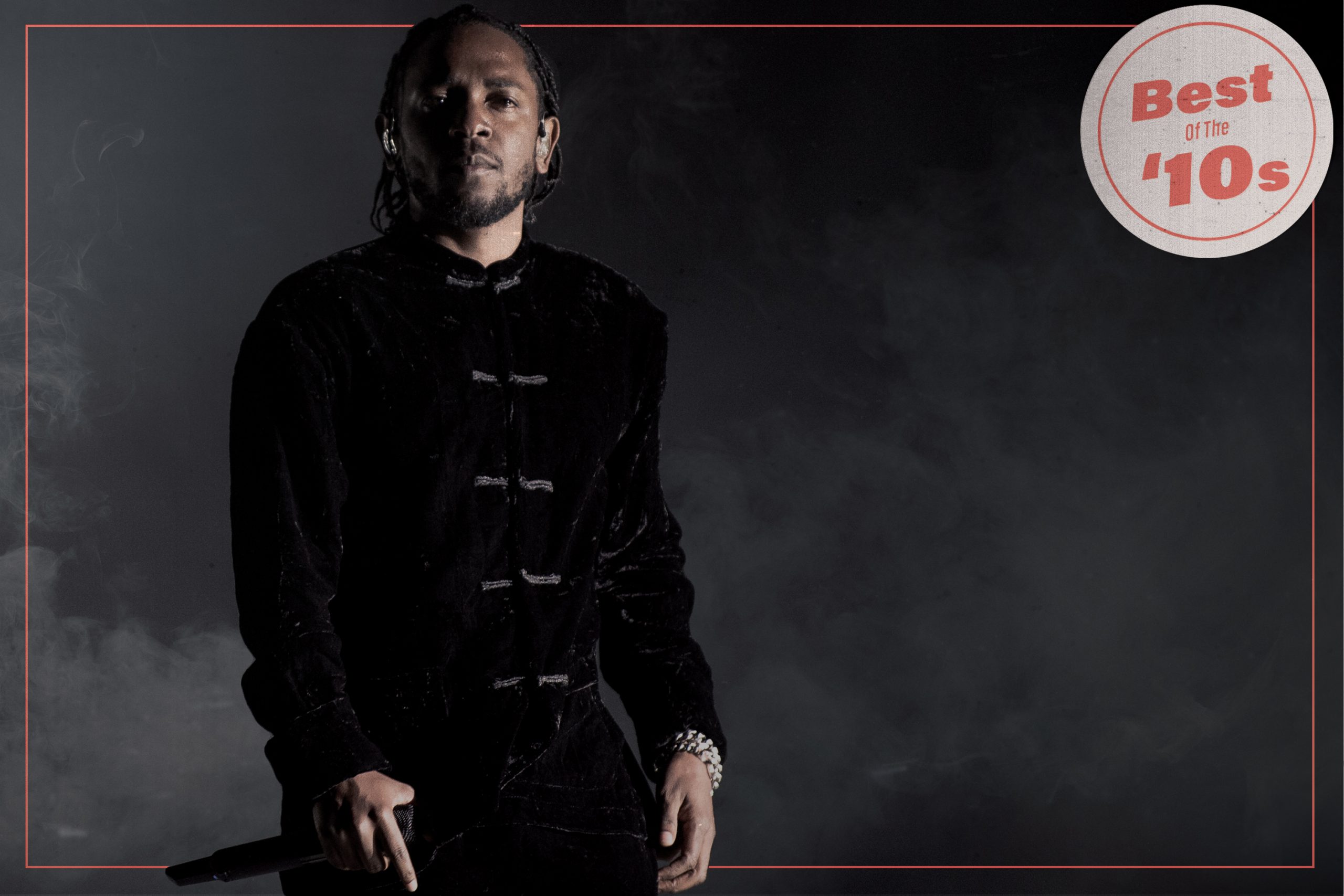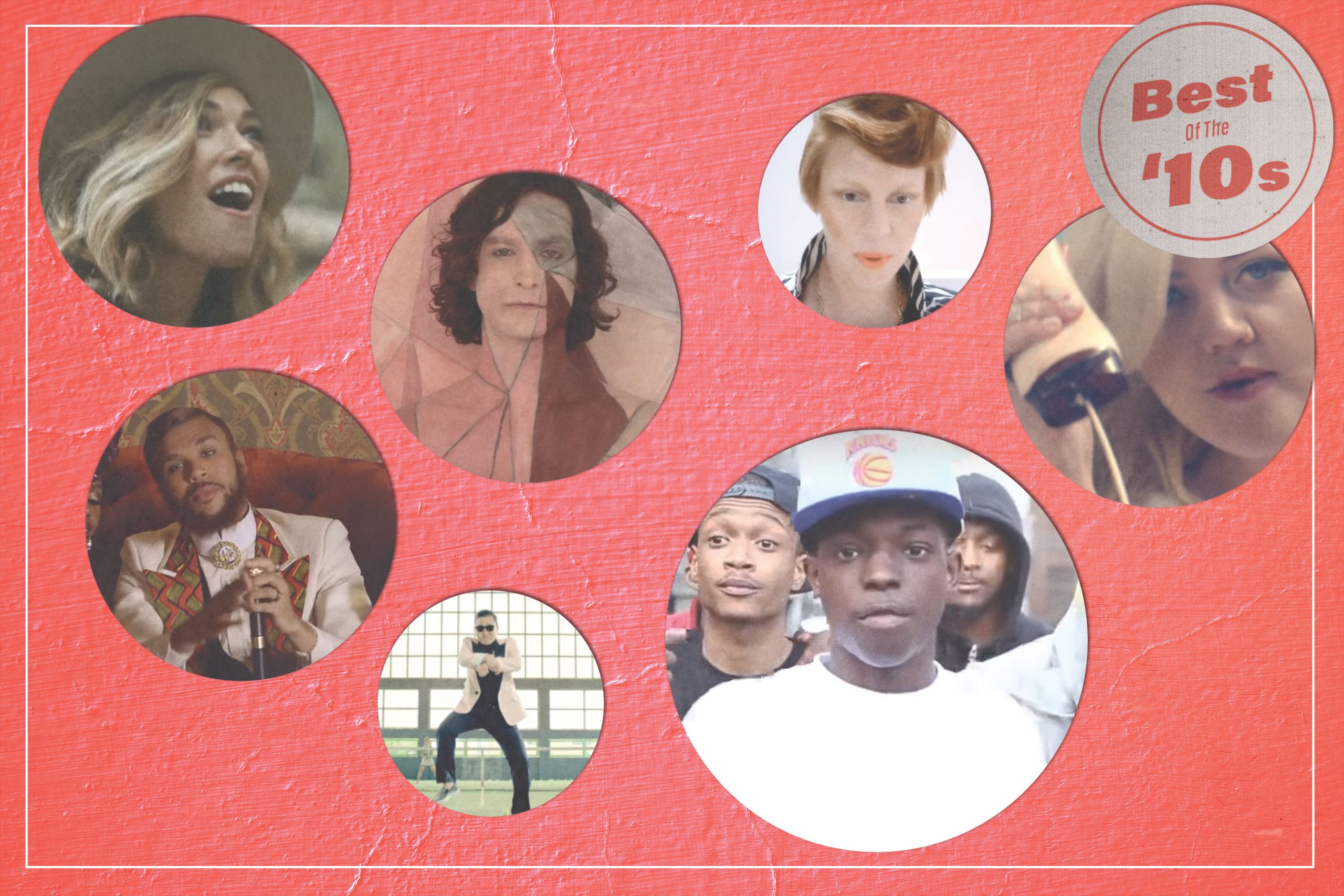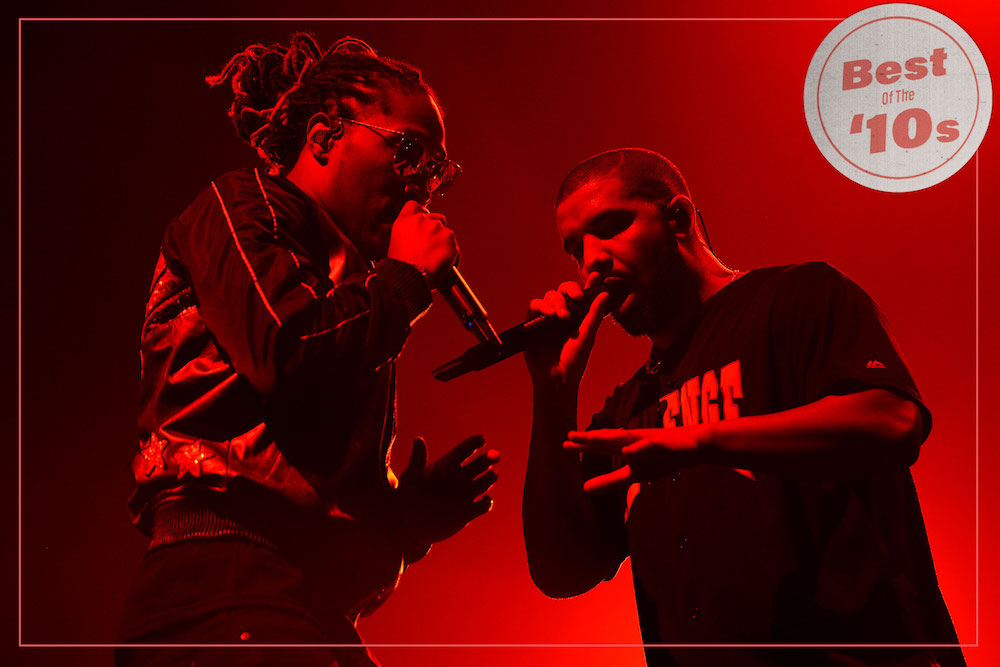"Bitch, where were you when I was walkin'?" It was a fair question from Kendrick Lamar Duckworth considering how many people had glommed on to him by the time To Pimp A Butterfly dropped, almost exactly at the midpoint of this decade. These 10 years made him not just a star but a guiding light, if not the center of his own solar system. The process was well underway when "King Kunta" heralded Butterfly's explosive tangle of anger, anxiety, and ambition. A vast array of listeners were ready to anoint him as some kind of savior, never mind that none of us knew the man and few understood where he came from or what he was going through.
I myself was not yet paying attention back in 2010, when the rapper once known as K.Dot released his first mixtape as Kendrick Lamar. He had been building steam in the rap-blog underground with support from a rising record label called Top Dawg Entertainment, whose founder and namesake Anthony Tiffith had signed the Compton product at age 16 on the strength of his scrappy 2004 debut project Y.H.N.I.C. (Hub City Threat: Minor Of The Year). By the start of this decade, Kendrick had kicked out three more mixtapes, changed his rap name to his real name, and joined forces with label-mates Jay Rock, Ab-Soul, and Schoolboy Q as Black Hippy. The group was frequently invoked in early coverage of TDE artists, but in hindsight it mostly functioned as a trampoline for the members' respective solo careers.
[videoembed size="full_width" alignment="center"][/videoembed]
None bounced harder or higher than Kendrick. His body of work in the 2010s towers over not just his TDE peers or even hip-hop at large but popular music as a whole. No one is flawless -- I hadn't forgotten his verse on Taylor Swift's "Bad Blood" remix so much as blocked it out -- but who else has been so prolific while remaining so consistently great? A very small handful of artists could arguably land three albums on a list of the decade's finest, but for Kendrick it was inarguable: good kid, m.A.A.d city, To Pimp A Butterfly, and DAMN. had to be included in Stereogum's top 100, and they all had to rank highly. Yet his dominant run this decade goes much deeper than those three landmark releases, into his pre-Interscope full-lengths, the projects he's released between major creative statements, his typically sterling guest appearances, and even his visual iconography. His decade has been a masterclass on how to be a mainstream superstar and a daring auteur all at once.
It began in 2010 with Overly Dedicated, that first mixtape as Kendrick Lamar. At the time, he was still rapping about the decision between seriously pursuing rap or dedicating himself to the drug trade, but even then his perspective stood out from the legions of MCs who've outlined similar conflicts. Though he hadn't yet evolved into the pensive whirlwind he'd later become, his talent, vision, and unique presence were already evident. Listening back to Overly Dedicated's post-midnight reflections, he was already the artist we know today, just greener: same poetic spirit, same subtly (and not so subtly) complicated cadences, same hero-worship for his personal pantheon of black icons, same lofty philosophizing and outré theological discourse, same ability to spin your head with evocative imagery and sheer technique alike. The raw material was all there, even if no one could have predicted what he'd do with it.
[videoembed size="full_width" alignment="center"][/videoembed]
Still, the leap from Overly Dedicated to official debut album Section.80 just nine months later was astounding. This is where I tuned in. I remember suddenly seeing the name Kendrick Lamar all over the place. I remember clicking on a stream of "A.D.H.D." And I remember being blown away by Kendrick's virtuoso take on the era's drug-fueled moodiness. Against glassy keyboard chords and hard-knock drum programming that phased in and out of the foreground, Kendrick twisted his voice into wild shapes and colors, like Robin Williams' Aladdin genie turned depressive party monster. He impressed with not just his rapid-fire delivery but the incredible pictures he painted with those words, be it the indelible hook "Eight doobies to the face, fuck that/ Twelve bottles in the case, nigga, fuck that" or the second verse's narrative about a flirtation where the physical and philosophical seemed to be intensifying in tandem.
Kendrick's bars on "A.D.H.D." were elusive yet incisive, the kind that made you think hard and rap along harder. How were we to interpret the repeated "fuck that" in the chorus? What were we to make of the woman at the party's perspective? How did all this come out one guy's brain, much less his mouth? Blessedly, Section.80 was littered with songs that good. The production was a massive upgrade, richly melodic and far-reaching in scope yet rooted in classic hip-hop. As a rapper, his worldview was distinct, his style even more so, remixing the genre's sonic and topical touchstones in ways that could be both revelatory and confounding but rarely failed to yield artistic rewards. Amidst the opening track's cascading pianos and sighing harmonies, he preached, "Fuck Your Ethnicity," establishing that neither the wisdom nor its delivery system would be conventional.
From there he kept coming at us from unexpected angles, spinning the retro sitcom brass of "Hol' Up" into jarring sexual fantasy and the urgent horn loop of "Rigamortus" into a machine-gun syllable splatter. His lyrics breathed new life into standard rap fare about gang violence and the political neglect that fuels it. Puritanical ideas about drugs and sex hung in uneasy tension with indulgence, a theme that would continue to manifest throughout his discography, sometimes in messy and controversial ways. There were nods to the Corinthian epistles and eschatology, to Aaliyah and Marcus Garvey. It was dense; it was expressive; it was art; it was pop. Its rewards were immediate. By the time "HiiiPower" played us out, a new hip-hop hero had been born -- a notion further stoked by stunning guest turns on albums like Drake's Take Care (where Kendrick was given a dark and bleary interlude all to himself) and A$AP Rocky's Long.Live.A$AP (where he easily won the rising-star posse cut "Fuckin' Problems").
[videoembed size="full_width" alignment="center"][/videoembed]
And that was before he had even signed to Dr. Dre's Interscope imprint Aftermath and dropped one of rap's all-time classic coming-of-age stories. With 2012's good kid, m.A.A.d. city, Kendrick sidestepped the stereotypical shiny, corporate, A&R-hobbled major-label debut. Instead, he delivered a concept album that burrowed into knotty storytelling, used its West Coast bangers as punctuation for long stretches of heady atmospherics, and was on the whole less poppy than the indie LP that got him signed in the first place. The album art billed it as "a short film by Kendrick Lamar," but it felt more like a full-length feature, like a hotshot director had been given free rein at a major studio and come away with a meditative blockbuster. It was certainly vivid enough to resemble a movie, this portrait of a young black man swept up into gang life and narrowly avoiding the jail time or early death that befall so many.
Judging by the bonus tracks and leaked outtakes -- including "Cartoon & Cereal," still regarded by many rap critics as Kendrick's finest song -- he could have easily stretched GKMC into a double album without diminishing the overall quality. But they might have stalled out the story's momentum, so they had to go. K.Dot was careful to make the pieces fit together into an engaging autobiography. Still, on their own, they worked as artfully constructed rap songs: the sweeping melodic swoon "Bitch Don't Kill My Vibe," the easygoing BBQ jam "Poetic Justice," the ominous party track "Swimming Pools (Drank)," the devastating epic-within-an-epic "Sing About Me, I'm Dying Of Thirst." And when Kendrick did decide to let 'er rip, as on "m.A.A.d. city" and the titanic flex "Backseat Freestyle," he proved his verbal acrobatics could toggle over into roaring aggression whenever he pleased.
[videoembed size="full_width" alignment="center"][/videoembed]
Speaking of which: The year after good kid, Kendrick came through with the most talked-about rap verse this side of Nicki Minaj's wide-eyed "Monster" tirade. Perversely, he did so on a goddamned Big Sean song. With "Control," Kendrick sent shockwaves through rap, calling out his peers and rivals by name, asserting his love for them alongside his desire to murder and erase them through the sheer magnitude of his verbiage. The rest of his lyrical onslaught was proof that he had the power to do exactly that. Here was a kid from Compton, California proclaiming himself the King Of New York, declaring, "I'm usually homeboys with the same niggas I'm rhymin' with/ But this is hip-hop, and them niggas should know what time it is."
The gauntlet was thrown. To be named in Kendrick's screed was to be honored and disrespected all at once, and pity the MC who was left out. Response tracks proliferated, both from those on the "Control" lyrics sheet and those omitted from it. Debate persisted for weeks. Even the decision not to respond, or to passive-aggressively brush it off like Drake did, was feverishly dissected by a horde of fans and journalists energized by this apparent end to years of rap detente. "Control" helped to solidify the notion of Kendrick Lamar as a gravitational force in hip-hop, arguably the best rapper alive, an emerging icon, a role model, a game-changer. He responded not with a victory lap but by freaking the fuck out.
It had been two and a half years since good kid, a period of seemingly endless touring, gradually magnifying attention, and constantly escalating expectations. Kendrick had accomplished a remarkable ascent, especially with no clearly established lane for a cerebral rap superstar like himself. He'd gone from performing in college cafeterias to playing the side stage Pitchfork Music Festival (with Lady Gaga looking on) to opening for Kanye West and Eminem to headlining festivals in his own right. He'd taken swipes at former ally and benefactor Drake in a 2014 BET Awards freestyle, establishing a sort of rap-supremacy cold war. He'd also taken over key influence Lil Wayne's spot as the rapper so big he appears on remixes by the likes of Imagine Dragons.
[videoembed size="full_width" alignment="center"][/videoembed]
Whatever the world was anticipating in the wake of Kendrick's rapid rise, it wasn't To Pimp A Butterfly. Despite the album's fixation on African royalty both literal and figurative and the way he shooed "monkey-mouthed motherfuckers" away from his throne, this was not the sound of a conquering king. Our narrator dug deep into self-doubt and self-loathing, detailing his battle with his own neuroses in passages like the breathless excoriation "u" and the lengthy address to 2Pac threaded throughout the album. Burdened by survivor's guilt and the crippling pressure of superstardom, besieged by the racial turmoil that sparked the Black Lives Matter movement, he lashed out against himself and everyone else within earshot. You could feel the claustrophobia, the paranoia, the pain, the temptation, the longing for release.
To soundtrack this meltdown, he melted down black music history and recast it in his own image. If GKMC shed light on the lives of an entire culture via one young black man's experience, TPAB was somehow both more interior and more universal, panning out to larger turmoil while digging deeper into Kendrick's personal struggle. That philosophy extended to the album's musical palette, which went beyond good kid's luxuriant West Coast rap symphonies and into an untamed mix of hip-hop, jazz, funk, and soul spanning generations. Rather than a stack of hits, it was a funhouse-mirror reflection of the chaos that was raging in America at that moment, alienating all sorts of different listeners with its frantic messiness and unflinching emotional honesty. You couldn't put it in a bowtie.
[videoembed size="full_width" alignment="center"][/videoembed]
Yet To Pimp A Butterfly was by no means a hopeless document. Opener "Wesley's Theory" rode in triumphantly, as if bringing the funk to Fury Road. The album's final movement of songs following the climactic, cathartic "The Blacker The Berry" gestured toward peace and self-acceptance. In between, there were moments of unadulterated swagger like "King Kunta" and "Hood Politics" and pure smoothness like "These Walls" and "Complexion (A Zulu Love)." And, of course, there was "Alright," a new kind of spiritual for a generation who lived in constant fear of being gunned down in the street by police. That song also marked a quantum leap in Kendrick's visual presentation, be it soaring over California streets in the music video (which he co-directed with Collin Tilley under his Little Homies guise) or performing atop a busted police car at the BET Awards.
The To Pimp A Butterfly sessions produced so much great music that untitled unmastered, an eight-song outtakes collection released the following year, still stands as a stunning if less-focused epilogue, the Amnesiac to Butterfly's Kid A. Even Kendrick's unfinished scraps were golden; untitled unmastered finished at #24 on the Village Voice's Pazz & Jop critic's poll. Yet despite the instantly iconic nature of To Pimp A Butterfly and its assorted ephemera, there was a sense that he might fold into his own self-contained world of prestige projects like Kanye, whose 2016 effort The Life Of Pablo featured Kendrick running wild over Madlib production on "No More Parties In LA." Maybe his future was releasing mammoth event albums and maintaining a presence on the radio by hopping on tracks like Travis Scott's "Goosebumps." Instead, he'd spend the rest of the decade fashioning himself as a worthy peer for Beyoncé, someone who has been able to spin off actual hits from her grandiose full-length projects (and whose 2016 album-film Lemonade featured even more Kendrick Lamar guest-star fireworks).
[videoembed size="full_width" alignment="center"][/videoembed]
First, he did so with DAMN. From the moment "HUMBLE." dropped at the dawn of spring 2017, with its magnificent shit-talk and thunderous piano-pounding beat and awe-inspiring music video, it was clear Kung Fu Kenny would be taking no prisoners this time around. The rest of the album arrived shortly thereafter and confirmed our suspicions: Kendrick was perfectly capable of thriving in the commercial lane, and he'd do it while maintaining his off-kilter artful touch. "HUMBLE." became his first #1 hit as a lead artist. The swagged-out Rihanna duet "LOYALTY.," the flickering ballad "LOVE.," and the ultra-catchy lyrical beatdown "ELEMENT." took over rap radio. From the monumental banger "DNA." to the miniature origin story "DUCKWORTH.," Kendrick established the a level of depth and complexity on par with Kendrick's prior masterpieces, yet by comparison DAMN. was wildly accessible, even breezy.
Despite its approachable appeal, DAMN. also made Kendrick the first popular musician to win a Pulitzer Prize. Some would argue that it was a stunt by the Pulitzer committee, a way for this prestigious institution to get a foothold in the mainstream. Others would say it was like when an actor or director wins a make-up Oscar for inferior work later in their career, when it feels more like a lifetime achievement award. But go back and listen to the one-two punch of "XXX." and "FEAR." and tell me DAMN. is anything but a staggering work of musical literature. It's the Kendrick Lamar album I turn to most often, the one I'd recommend to any new listener starting out.
[videoembed size="full_width" alignment="center"][/videoembed]
Having established his genius several times over, Kendrick rounded out his decade with one last magic trick: transforming a movie soundtrack tie-in album into a work of art. His Black Panther companion album played out like a mixtape and a high-definition dream sequence all at once. In practice, it was an all-star compilation haunted by Kendrick at every turn, aesthetically consistent both within itself and with the Marvel movie to which it was attached. The soundtrack contributed to the feeling of Black Panther as a major cultural event -- a critically acclaimed superhero movie that doubled as a celebration of black excellence. His videos for the SZA duet "All The Stars" and the Jay Rock-led posse cut "King's Dead" were works of cinema unto themselves.
By the end of the decade, Kung Fu Kenny's resume was real enough for two millenniums. He'd risen from hip-hop's minor leagues to become music's most dependably awesome creative force, a rap superstar whose reach transcends genre and demographic -- headlining Coachella, opening the Grammys, achieving every marker of industry success without compromising his craft. There is no such thing as a universally beloved artist, but few command such respect and even fewer deserve it. The standard of excellence he maintained throughout the 2010s can't last forever. Maybe he'll fall off sooner than I think. For now, he runs the game, got the whole world talkin'.
[videoembed size="full_width" alignment="center"][/videoembed]






